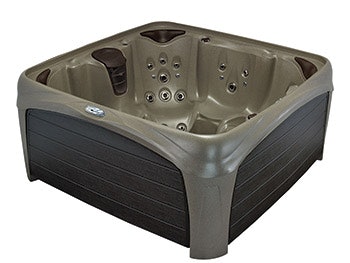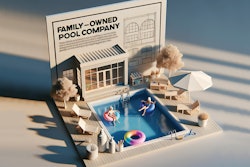The rotomolded spa is somewhat of a black sheep in the hot tub industry. In a glistening showroom, rotomolds don't necessarily have the luster and curb appeal of their acrylic siblings. They often lack the luxe features customers love. And their entry-level price points don't turn the same profit (or commission) as, say, a high-end acrylic.
"I've been in the business doing shows for 20 years. And I run into old friends of mine that I haven't seen in a long time, and they laugh at the rotomolds," says Pete Steiner, CFO of the Hot Tub Loft (Boynton Beach, Fla.).
While some may look down their nose at the category, many spa dealers consider the rotomold a valued — even essential — part of business. As we found in our State of the Industry survey, a whopping 45 percent of spa retailers reported they carry rotomolded spas. And of those who carry them, 23 percent reported sales are increasing compared to acrylic spas.
 Dream Maker Spas' Crossover series is made with the company's proprietary Syncrylic material, which lends an acrylic-like shine to the spa.
Dream Maker Spas' Crossover series is made with the company's proprietary Syncrylic material, which lends an acrylic-like shine to the spa.
"We count on selling a substantial number of rotomolded spas every month. It's not just a promotional item, it's a regular part of what we do," says Craig Ecelbarger, owner of Recreational Warehouse, which has three locations in Southwest Florida.
Here, pros from three hot tub retailers share their thoughts about the rotomolded spa's appeal, the broad market it serves and its industry perception.
A BROADER MARKET
According to Eric Cassidy, vice president at Valley Pool & Spa, a firm that owns five stores in the greater Pittsburgh area, rotomolds appeal to a wide swath of customers. Young families, for example, appreciate their durability — they're essentially kid-proof. Many models only require a 110-volt outlet, making installation easy. Even their typically shorter height is appealing to older customers looking for a tub that is easy to get in and out of.
And then there's price point, by far a rotomold's biggest advantage. Running from roughly $2,000 to $6,000, the affordable pricing broadens a dealer's market share to include a new group of consumers, like the impulse buyer.
RELATED: Invest in Rotationally-Molded Spas
"The impulse buyer is in the store not even specifically to shop hot tubs. Then they see the rotomolds and realize how easy it would be to own one because they're light, they're easy to move, they're plug and play and they're inexpensive," Cassidy says.
 The new Suite Spa Collection from Dream Maker Spas is an all-in-one spa solution that includes an umbrella, cover lifter, steps and rail, making it ideal for customers who prioritize convenience.
The new Suite Spa Collection from Dream Maker Spas is an all-in-one spa solution that includes an umbrella, cover lifter, steps and rail, making it ideal for customers who prioritize convenience.
A FAMILIAR BUYER
A common notion in the industry is the idea that a rotomold is typically an entry-level or gateway spa. In fact, the primary market for a rotomolded spa is second- and third-time buyers.
"People who previously owned a hot tub, they know what hot tubs are about and they sometimes realize they do not need everything they had previously," Cassidy says. "Maybe they just like to soak in hot water, or maybe they don't like a ton of jets hitting them. They can still get the same benefits from the rotomold without spending as much as they did before."
"The first time you buy a hot tub, you may buy way too big. You'll buy 30,000 jets and you know you don't use those," adds Clay Norman, CEO of the Hot Tub Loft. "Now you're done with the parties, you're done with the lifestyle and all you really want is hydrotherapy."
Today's rotomolds are especially appealing to former spa owners because of special features that help mitigate the hardships of spa ownership.
"Our customer is not somebody that's like, 'Hey, I want another hot tub, let's look at rotomolds,'" Norman says. "These are people that happen to be at a fair and walk by, see a rotomold and say, 'Dude, I loved our hot tub, but we had so many problems with the cover and the wood, and we had to spend $1,400 to build a platform and have it hardwired.' And they see these and they get excited because it solves all their problems."
The Hot Tub Loft carries the Tuff Spas line, the hallmark of which is the Tuff Top Cover system. Made from the same material as the spa itself, the cover is lightweight, yet durable, is easily opened by one person, can hold more than 500 pounds and has a lifetime warranty — a tantalizing option for former spa owners who have been burned by acrylic spa covers.
"It's that damn [acrylic] cover that drives people insane," Norman says. "It's waterlogged. You don't want to go in your hot tub because it's so heavy and you can't remove it by yourself. So these are the people that when they walk by and we throw over the cover, and you jump on the cover and sit on the cover, they freak out."
"It's an emotional purchase," he adds. "Way more of an emotional purchase than an acrylic hot tub because of the cover and the uniqueness."
 Tuff Spas' unique cover system appeals to former hot tub owners who struggled with waterlogged covers.
Tuff Spas' unique cover system appeals to former hot tub owners who struggled with waterlogged covers.
UPGRADED DESIGN
Rotomold spa manufacturers have made great strides in terms of aesthetic design, especially among higher-end models. At Valley Pool & Spa, Dream Maker Spas' Crossover collection is seeing a lot of interest from consumers who want the features an acrylic provides — like two-pump systems, ozonators and stereos — without the price tag.
"It doesn't look like a typical rotomold. Separate skirting panels, the corners, different material. It really does look somewhere between a rotomold and an acrylic," Cassidy says.
RELATED: Trending Now: Hot Tub Design
"A lot of customers will bump up to that model because maybe they don't really need the plug and play; maybe they can already do the 240-volt setup, so they don't have to spend the money they would have to on that acrylic and they can still get the features," he adds. "Or you might have an acrylic customer that wants the features but can't afford it. Those people step down to the rotomold Crossover."
On the other hand, the rotomolded spa's classic, sturdy design can work in a salesperson's favor.
"We like to say we're the 'anti-hot tub' hot tub. We really are," Norman says. "We tell people openly, 'Hey, you're not getting a stereo, you're not getting a television, you're not getting waterfalls, you're just getting a hot tub that doesn't break and you're never going to replace your cover.'"
DEALER DIVIDE
Despite the benefits they offer, the rotomold's perception as a "bargain" hot tub pushes some dealers to frown on rotomold buyers or ignore the category entirely.
"I've talked to enough dealers over the years, and there are people who you sense might be treating the rotomolded customer a little bit as a second class citizen," Ecelbarger says.
Much of that stigma stems out of concern that rotomold sales will eat into the healthy profits acrylic sales provide. And while dealers admit they occasionally lose an acrylic sale to a rotomold, the category is still quite fruitful in its own right.
"We sell rotomolded spas at the same profit margin percent that we sell everything else," Ecelbarger says. "We do not treat the category like a lesser margin category. Our attitude with our customers is basically, 'We don't care which spa you buy, we just want you to buy one you'll be happy with.'"
The rotomold debate is also a philosophical one. Would you rather sell only to those who can afford to spend at least $6,000 or $7,000 on an acrylic spa? Or would you rather offer multiple price points to potentially appeal to more customers?
RELATED: Used Hot Tub Sales: A Growing Market
The answer will differ based on your location, goals, market and other factors. For Ecelbarger, a dealer who specializes in high-volume sales, offering spas at all price points allows him to cater to everyone — impulse buyers, budget shoppers, former spa owners — and keep them from spending their money elsewhere.
"I think we in the industry should be more than happy to take $3,500 from any customer that would like to give it to us," he says, "and let them start feeling good tomorrow instead of a year or two from now."








































